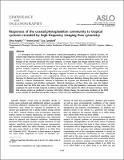Por favor, use este identificador para citar o enlazar a este item:
http://hdl.handle.net/10261/133155COMPARTIR / EXPORTAR:
 SHARE SHARE
 CORE
BASE CORE
BASE
|
|
| Visualizar otros formatos: MARC | Dublin Core | RDF | ORE | MODS | METS | DIDL | DATACITE | |

| Título: | Responses of the coastal phytoplankton community to tropical cyclones revealed by high-frequency imaging flow cytometry |
Autor: | Anglès, Silvia CSIC ORCID; Jordi, Antoni CSIC ORCID; Campbell, Lisa | Fecha de publicación: | 26-may-2015 | Editor: | Association for the Sciences of Limnology and Oceanography | Citación: | Limnology and Oceanography 60(5): 1562-1576 (2015) | Resumen: | To investigate the response of a subtropical coastal phytoplankton community to tropical cyclones, we utilized high temporal resolution (hours) data from the Imaging FlowCytobot (IFCB) deployed in the Gulf of Mexico. In 2010, four tropical cyclones (two during June-July and two during September) struck the area. Passage of the cyclones produced two major impacts: (1) storm surges and strong onshore winds, and (2) heavy rains producing substantial freshwater discharge and decreased salinity. The phytoplankton community showed a rapid response to the passage of the cyclones with increased abundance. Using principal component analysis, responses during storm surges and after freshwater discharges were distinguished and considerable changes in community composition were revealed. Responses to storm surges were characterized by an increase of diatoms. Freshwater discharges triggered increases in dinoflagellates and other flagellates (prasinophytes, euglenophytes, and cryptophytes) relative to the other groups. In June-July, substantial increases in diatoms were also observed. The response to freshwater discharge during this period was dominated by a diatom (Thalassiosira), whereas in September the response was dominated by two dinoflagellates (Akashiwo sanguinea and Polykrikos hartmannii). Observed abundances of these three taxa were the highest recorded from the IFCB time series. The short-term responses of the phytoplankton community revealed here emphasize the need for high temporal resolution sampling to fully capture the effects of tropical cyclones. Given that extreme storms are predicted to increase with future climate change, the taxonomic resolution of the IFCB is also valuable for detecting taxa-specific responses, which can have implications for ecosystem functioning. | Versión del editor: | http://dx.doi.org/10.1002/lno.10117 | URI: | http://hdl.handle.net/10261/133155 | DOI: | 10.1002/lno.10117 | Identificadores: | doi: 10.1002/lno.10117 issn: 1939-5590 |
| Aparece en las colecciones: | (IMEDEA) Artículos |
Ficheros en este ítem:
| Fichero | Descripción | Tamaño | Formato | |
|---|---|---|---|---|
| Angles-lno-2015-v60-p1562.pdf | 2,34 MB | Adobe PDF |  Visualizar/Abrir |
CORE Recommender
SCOPUSTM
Citations
35
checked on 20-abr-2024
WEB OF SCIENCETM
Citations
35
checked on 25-feb-2024
Page view(s)
204
checked on 23-abr-2024
Download(s)
282
checked on 23-abr-2024
Google ScholarTM
Check
Altmetric
Altmetric
NOTA: Los ítems de Digital.CSIC están protegidos por copyright, con todos los derechos reservados, a menos que se indique lo contrario.
